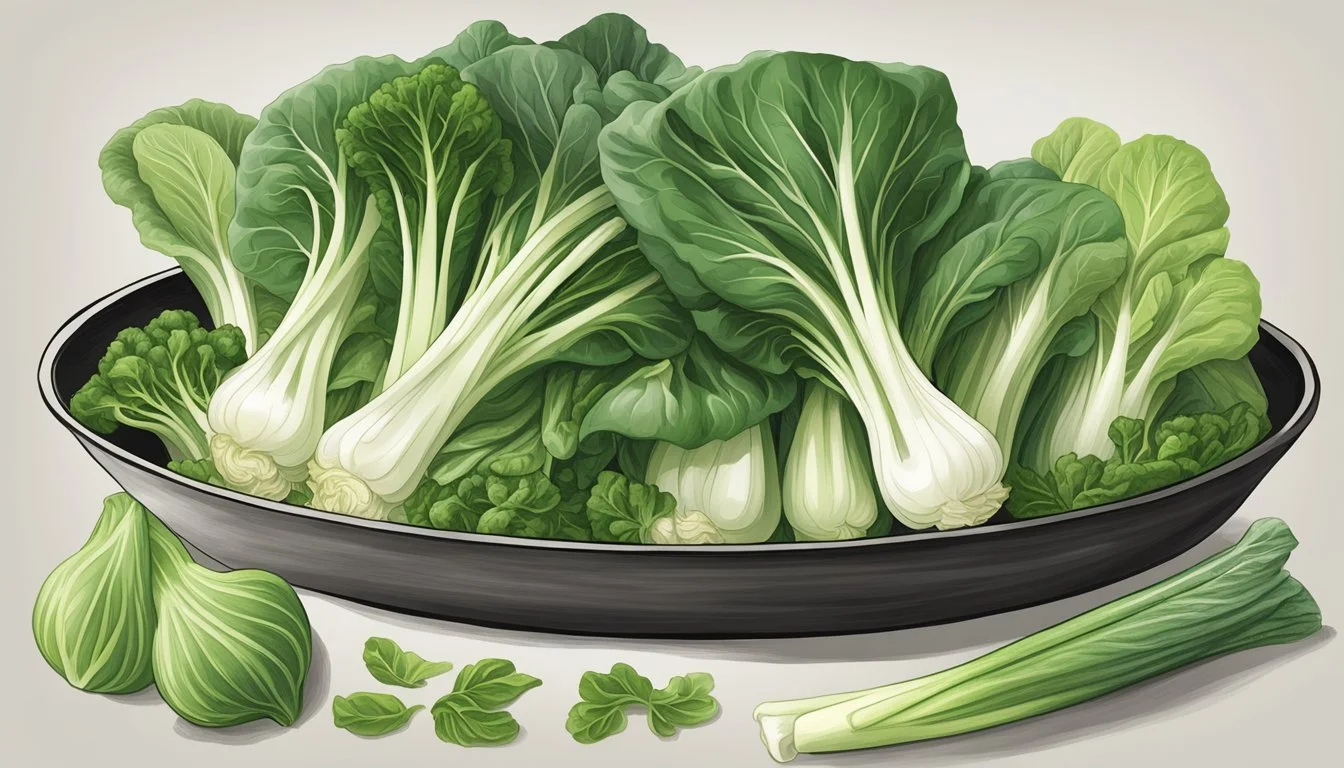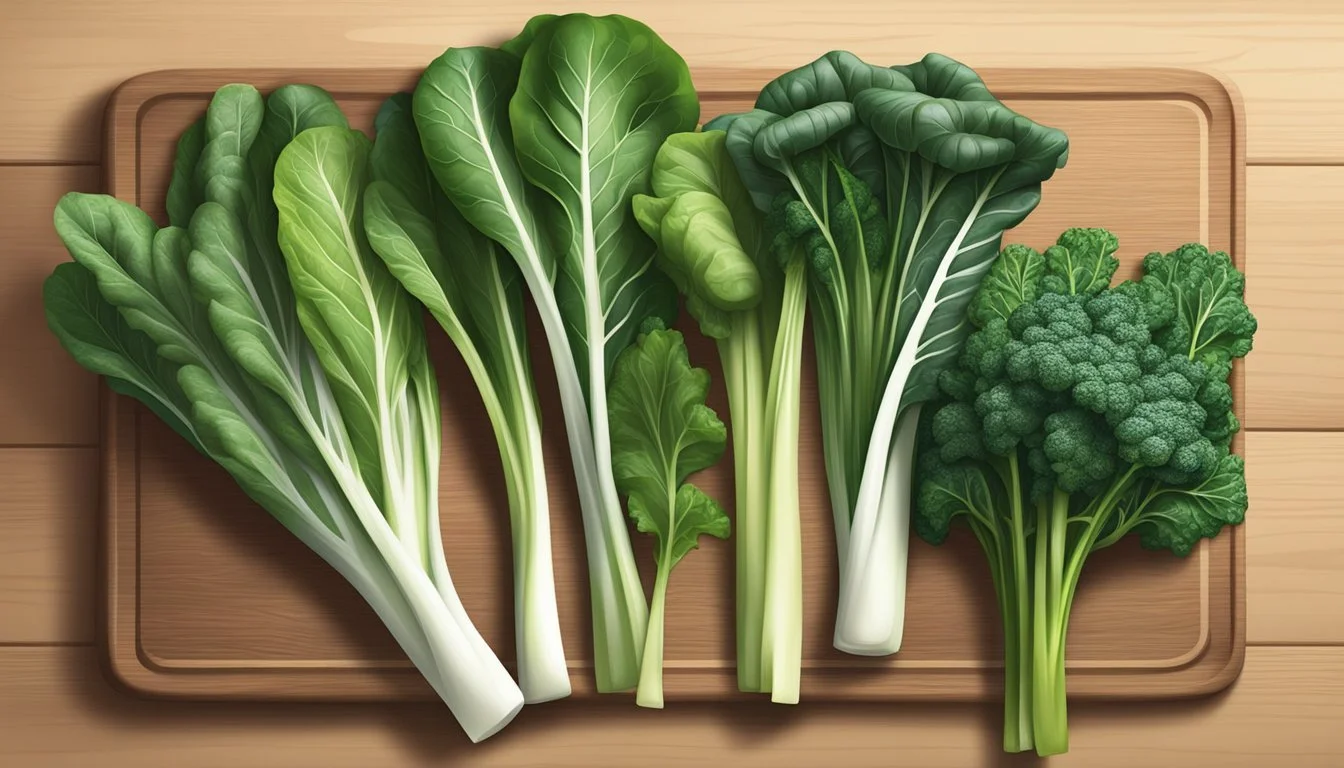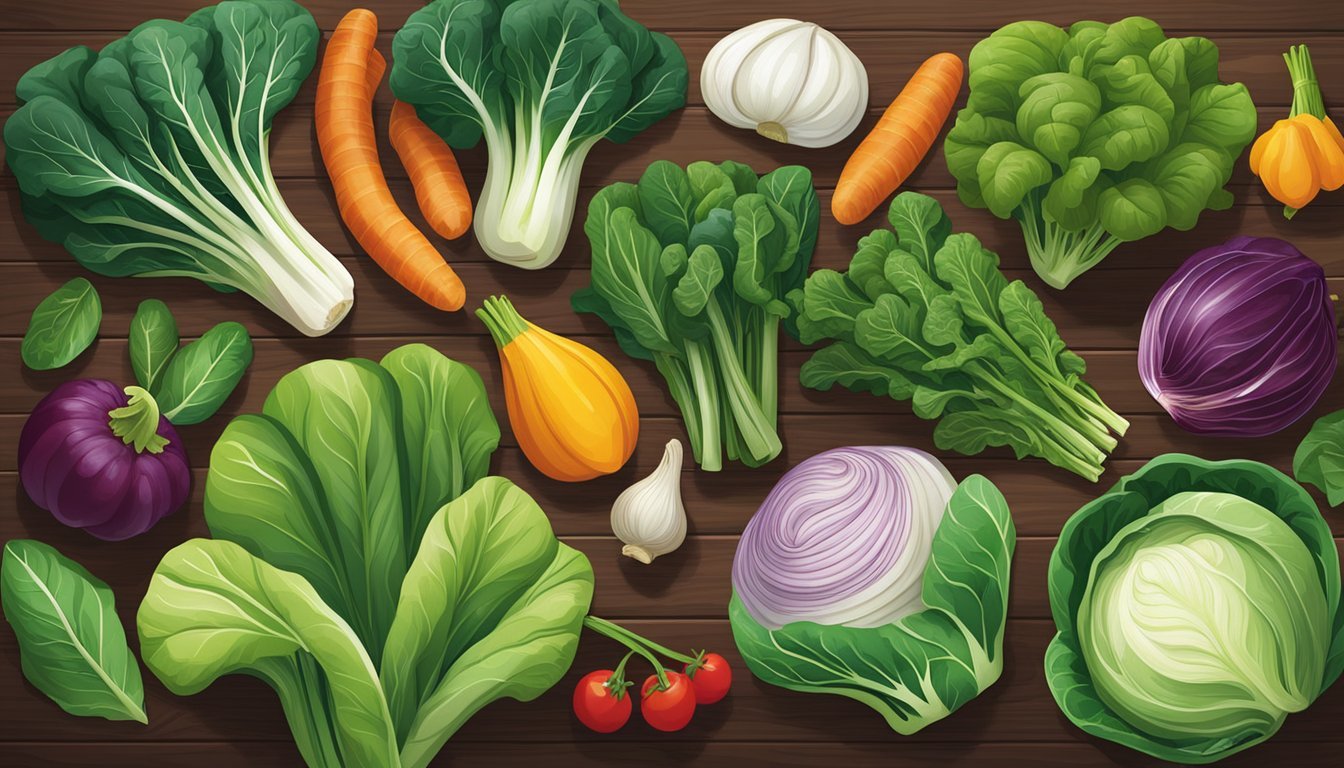Pak Choy Substitutes
Best Alternatives for Your Recipes
Navigating the aisles of your local market, you may find yourself in search of pak choi for your favorite Asian dishes. This nutritious vegetable, also known as bok choy, is a staple in many recipes, but sometimes it can be hard to come by. When pak choi isn't available, there are several excellent substitutes that can carry the same flavors and textures into your cooking.
Napa cabbage often stands out as a top alternative, bringing its tender leaves and subtle taste to your stir-fries and soups. Swiss chard is another great option, closely mimicking the texture with a slightly different flavor profile that leans more toward spinach. These alternatives not only integrate well in a variety of Asian cuisines but also ensure your dishes remain vibrant and nutritious.
For a sweeter touch akin to baby pak choi, pea shoots from sugar snap peas can be an ideal choice. Pea shoots capture the crispness and tenderness that make pak choi unique, making them perfect for salads and quick sautés. With these substitutes, you can easily find the right ingredients to keep your culinary creations both authentic and satisfying.
Understanding Pak Choi
Pak Choi, also known as bok choy, is a Chinese cabbage known for its dark green leaves and crisp, juicy stalks. It is not only versatile in culinary applications but also rich in essential nutrients that offer multiple health benefits.
Characteristics of Pak Choi
Pak Choi features dark green leaves and white or light green stalks, both of which are edible.
The leaves are tender and have a slight spinach-like flavor, while the stalks are crisp and juicy.
This vegetable is commonly used in Asian cuisine, particularly in stir-fries, soups, and salads.
Its botanical name is Brassica rapa, and it belongs to the same family as kale, broccoli, and cabbage.
The crunchy texture of Pak Choi makes it a favorite for adding contrast in both taste and texture to various dishes.
It thrives in cool climates and is often harvested in the spring and fall.
Nutritional Profile
Pak Choi is low in calories but high in nutrients, making it a staple for health-conscious diets.
It is rich in Vitamins A, C, and K, which are crucial for maintaining healthy skin, vision, and blood clotting.
Additionally, it provides an excellent source of calcium, iron, and potassium, essential for bone health, oxygen transport, and muscle function.
Pak Choi contains significant amounts of magnesium and fiber, aiding in digestion and metabolic processes.
Furthermore, its dark green leaves are loaded with antioxidants, which help combat oxidative stress and inflammation.
Due to its high nutrient content and low-calorie nature, Pak Choi is an excellent addition to a balanced diet, providing a range of health benefits without compromising on flavor or texture.
Common Uses of Pak Choi
Pak choi is a versatile ingredient in many dishes, providing a crunchy texture and tender leaves that complement a variety of cooking methods. It is commonly used in Asian cuisine, particularly in stir-fries, dumplings, soups, and salads.
Incorporating Pak Choi in Recipes
Pak choi is a staple in Asian dishes. It is frequently added to stir-fries, where its crunchy stalks and tender leaves provide contrast to soft vegetables and meats. In dumplings, pak choi adds a refreshing bite and subtle flavor. When used in soups, such as miso or wonton soup, it retains its texture while absorbing the broth's flavors. Salads benefit from raw pak choi, which can be thinly sliced and mixed with other greens.
Cooking Tips for Pak Choi
When preparing pak choi, proper cooking techniques enhance its natural flavors. For braising, cook it in a savory broth until the stalks are tender. Sautéing with garlic and a touch of oil brings out a richer flavor while keeping it crisp. For a quick method, frying it in a hot pan with minimal oil ensures it stays crunchy. Pak choi can also be enjoyed raw in salads, where it adds a crisp and refreshing element.
Selecting the Best Substitutes
When selecting substitutes for pak choy, consider the flavor, texture, and versatility of the alternatives to ensure they complement the intended dish optimally.
Criteria for Choosing Substitutes
Flavor is a critical factor. Pak choy has a mild, slightly sweet taste which can sometimes contain a faint bitterness. Opt for substitutes like Napa cabbage or Swiss chard that offer a similar mild flavor profile. Texture is equally significant due to pak choy's crispiness and tender leaves. Alternatives such as pea shoots or watercress provide a good textural match. Nutrient-rich replacements are also important; pak choy is valued for its vitamins and minerals, so choose substitutes that offer comparable nutritional benefits.
Versatility of Substitutes in Various Dishes
Different dishes require different substitute properties. In stir-fries or soups, Napa cabbage stands out for its ability to maintain crunch and sweetness when cooked. For salads or raw applications, watercress provides a peppery flavor and rich nutrients, albeit without the same crunch. Swiss chard offers a combination of tender leaves and a slightly bitter flavor, making it suitable for a variety of cooked dishes due to its resilience and adaptability to different cooking methods. These substitutes allow for flexibility and maintain the integrity of the dish while offering a comparable culinary experience.
Top Pak Choi Substitutes
When searching for substitutes for pak choi, it's essential to consider textures, flavors, and how the substitutes work in various dishes. This section explores the best options to replace pak choi in your recipes.
Napa Cabbage
Napa cabbage, also known as Chinese cabbage, is one of the go-to substitutes for pak choi. It shares a similar mild flavor and tender texture. Napa cabbage features light green leaves that can be used in stir-fries, soups, and salads. The leafy green's fibrous texture and slightly sweet taste provide a versatile complement to various dishes, making it a suitable choice for most recipes that call for pak choi.
Swiss Chard
Swiss chard offers another excellent alternative. It has dark green leaves and a slightly bitter taste, mimicking pak choi's flavor profile. The leaves are often used like spinach, while the stems can add a crunchy texture similar to pak choi. Swiss chard is nutrient-rich, containing vitamins A, C, and K. Its versatility makes it perfect for stir-fries, soups, and sautéed dishes, providing both nutritional value and a pleasant taste.
Mustard Greens
Chinese mustard greens, also known as gai choy, are a bold substitute. They possess dark green leaves and a tangy, slightly bitter flavor that differs slightly from pak choi but can enhance various dishes. These greens can be stir-fried, added to soups, or used in dumplings. Their vibrant green color and crunch are suitable for recipes where a stronger flavor is desired.
Spinach
Spinach is a widely available substitute that works well due to its tender texture and mild taste. While it doesn't have the same crunch as pak choi, spinach can easily be incorporated into stir-fries, soups, and smoothies. It is packed with nutrients such as iron and vitamin K, making it a healthy substitute. Its versatility and ease of preparation make it a convenient option for many dishes.
Other Alternatives
Several other vegetables can replace pak choi, depending on the recipe. Kale offers a more robust, slightly bitter flavor suitable for hearty dishes. Celery provides a similar crunch but with a more neutral taste, making it less ideal for recipes requiring a strong, leafy flavor. Broccoli and Chinese broccoli deliver a different texture but can work in stir-fries and soups. Baby bok choy remains the closest in flavor and texture but is often smaller and sweeter. Always consider the texture and flavor when selecting the best substitute for your dish.
By understanding the unique qualities of each substitute, you can confidently replace pak choi in any recipe, tailored to your diet and culinary preferences.
Maintaining Flavor and Nutritional Value
Using substitutes for pak choy in recipes requires careful consideration to preserve both flavor and nutritional benefits. Adjusting recipes and proper storage are crucial to achieving the best results.
Adjusting Recipes Accordingly
When replacing pak choy in Asian dishes like stir-fries, soups, or spring rolls, choose alternatives that match its crispiness and mild, slightly bitter flavor. Swiss chard, napa cabbage, and spinach provide comparable textures and health benefits. Swiss chard has a slightly bitter taste, akin to pak choy, and a crisp stem.
Napa cabbage delivers a similar texture and taste, making it ideal for stir-fries and salads. Spinach, although softer, is nutritious and integrates well into many recipes. Use a 1-to-1 ratio when substituting to maintain balance. It is essential to taste dishes during cooking to ensure the seasoning complements the new flavors.
Storage and Shelf Life
Proper storage methods ensure that substitute vegetables remain fresh and retain their nutritious qualities. Many leafy greens, like Swiss chard and spinach, can be stored in the fridge for several days. Use airtight containers or plastic bags to keep them crisp. Add a paper towel into the bag to absorb excess moisture and prevent wilting.
Napa cabbage can stay fresh for up to a week when stored in a fridge crisper drawer, wrapped loosely in plastic wrap. Regularly check stored vegetables for any signs of spoilage, as fresh ingredients are crucial for achieving the best flavor and maintaining nutritional value. Proper storage maximizes shelf life and ensures your dishes are both flavorful and healthful.
Exploring Lesser-Known Substitutes
When looking for alternatives to bok choy, one can find several less common yet flavorful leafy greens. Understanding these options helps create dishes with unique textures and tastes, suitable for various cuisines.
Asian Leafy Greens
Gai Lan (Chinese broccoli) features dense stems and a slightly bitter taste. Its firm texture contrasts well in stir-fries.
Yu Choy offers milder flavors with sweet, juicy stems. This leafy green works well in soups and salads due to its tender texture and versatility.
Choy Sum, another Asian green, provides a slightly sweet taste and crunchy texture. It’s great for both sautéing and steaming.
Tatsoi has a more delicate, mild flavor similar to spinach. Its small, spoon-shaped leaves are perfect for adding to salads or as a garnish.
Applying Substitutes in Western Cuisine
Using substitutes like Chinese celery in Western dishes can introduce new flavors. Chinese celery’s strong, slightly bitter taste pairs well with lemon juice and nuts in salads.
Napa cabbage can replace bok choy in various Western recipes, providing a closer match in texture and taste. Its juicy leaves maintain their crunch in dishes like coleslaw.
Swiss chard is ideal for those who want a leafy green with a hint of bitterness. It can be sautéed or added to soups, offering a similar experience to bok choy but accessible in many local markets.
These substitutes not only diversify flavor profiles but also bring nutritious benefits to Western cuisine, expanding the range of ingredients available for creative cooking.
Availability and Seasonality
Pak choy, also known as bok choy, is a versatile leafy green often used in Asian cuisine. When it is not available, there are several substitutes you can consider, both from local stores and home gardening.
Finding Substitutes at Local Stores
Pak choy can be found in most grocery stores, especially those with a robust produce section. Asian markets are an excellent source, often carrying fresh, high-quality selections. For substitutes, popular choices include Napa cabbage, baby spinach, and Swiss chard.
When shopping in regular supermarkets, look for these vegetables in the fresh produce section. Napa cabbage offers a similar crunchy texture, while Swiss chard can mimic the leafy part. Baby spinach can work well, particularly in soups and stir-fries.
Seasonality plays a role in availability. Pak choy and its substitutes are typically more abundant in spring and fall. Seasonal variations can affect the freshness and cost, so it's wise to check local markets and farmer's stands during these times.
Gardening and Home-Grown Alternatives
For those interested in gardening, growing pak choy or its substitutes can be rewarding. Pak choy is a cool-season crop and thrives in moderate climates. It can be harvested within 45-60 days, making it an excellent choice for home gardens.
Other vegetables like Napa cabbage, mustard greens, and kale can be cultivated similarly. Plant these leafy greens in well-drained soil with ample sunlight. They require regular watering and are relatively low-maintenance.
By growing your own, you ensure a fresh and nutritious supply of vegetables. Planting a mix of these substitutes ensures a continuous harvest and adds diversity to your meals.






